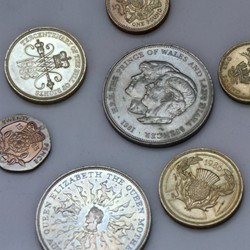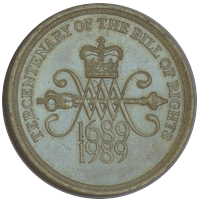British coins from the 1980s

In the 1980s Britain had three new coins, the 20p, the £1 and the £2.
The replacement of the pound note with a coin and the diminutive 20p continued a trend. Our coins were getting smaller. The last major change to our currency was decimalisation in 1971. Since then the pound had reduced to one third of its 1971 value.
There were two commemorative crowns issued. The first was to celebrate the Queen Mother's 80th birthday (1980). The second was for the wedding of Prince Charles and Lady Diana Spencer (1981). The Charles and Diana crown was the last one. Later commemorative silver coins had a value of £5.

New coin issues and changes
- 1980 - Crown (25p) issued for the Queen Mother's 80th birthday
- 1981 - Crown (25p) issued for Wedding of Prince Charles and Lady Diana Spencer
- 1982 - 20p piece introduced
- 1983 - £1 coin introduced
- 1984 - Decimal halfpenny withdrawn from circulation - last ones minted for circulation in 1983
- 1985 - New obverse portrait by Raphael Maklouf on all coins
- 1986 - £2 coin issued for Commonwealth Games in Edinburgh
- 1989 - £2 coin issued for Tercentenary of the Bill of Rights/Tercentenary of the Claim of Right
20p coin 1982

The Royal Mint announced two new coins in February 1982. A new one pound coin, which would appear in 1983 and a 20p coin that would available later in 1982. [1]
The new 20p coin was a small, light, seven-sided piece. It echoed the shape and rounded corners of the 50p, but was much smaller and lighter. The obverse had Arnold Machin's portrait of the Queen, as on the other coins surrounded by a border.
William Gardner designed the reverse. It was an English rose under a crown.
The idea behind the 20p was to reduce the weight of change. People had complained about bulging pockets. For some time there was a clamour for a coin larger in value than 10p, but smaller than 50p.
The new 20p did not please all. Merseyside busmen went on strike because the 20p did not fit their machines. They would have to carry them in their pockets putting them at greater risk from muggers. [2]
Some people thought the new 20p coin looked foreign. Others thought it would be confusing for older people. [3]
It was a reincarnation of a Victorian coin, the double florin or four shilling piece, but that was long-forgotten by 1982. The double florin was a much larger coin, but had its own problems. It was easily confused with a crown.
The 20p fits in better with today's coins than it did in 1982. With our smaller 5p and 10p coins, it does not seem out of place.
£1 coin
The pound coin was also controversial when it was introduced in 1983. It was the first time since 1914 that one pound had been a coin. In 1914, the coin was a gold sovereign. In 1983 it was a gold-coloured alloy of copper. For more information see What could you buy for a pound coin in 1983?.
The reverse was designed by the Royal Mint's Chief Engraver, Eric Sewell. Sewell had been at the Mint since 1960. The design was of the Royal Coat of Arms.
There was a new design each year. They alternated themes of the United Kingdom, Scotland, Wales, Northern Ireland and England. Designs issued in the 1980s were:
| Year | Theme | Design | Designer |
|---|---|---|---|
| 1983 | United Kingdom | Royal Coat of Arms | Eric Sewell |
| 1984 | Scotland | Crown & thistle | Leslie Durbin |
| 1985 | Wales | Crown & leek | Leslie Durbin |
| 1986 | Northern Ireland | Crown & flax | Leslie Durbin |
| 1986 | England | Crown & oak tree | Leslie Durbin |
| 1988 | United Kingdom | Royal shield | Derek Gorringe |
| 1989 | Scotland | Crown & thistle (as 1984) | Leslie Durbin |
The series continued into the 1990s and 2000s
Two pound coin

The Royal Mint issued two two-pound coins in the 1980s.
The first in 1986 was issued to celebrate the Commonwealth Games in Scotland. It featured a thistle design by Norman Sillman.
The second, issued in 1989, celebrated the Tercentenary (300 years) of the Bill of Rights in 1689. It was an Act of Parliament in 1689 which set out some basic rights. At the same time a different coin was issued in Scotland. It had a Scottish instead of an English crown and an inscription: 'Tercentenary of the Claim of Right'. The Claim of Right was an Act passed by the Scottish Parliament in 1689. It set out some key UK and Scottish constitutional law.
John Lobban designed the reverse of both coins.
References
[1] 'A yellow pound for your pocket' by Tony Samstag, published in The Times, 11 February 1982, page 1
[2] 'Mersey busmen go on strike over 20p coin', published in The Times, 10 June 1982, page 3
[3] 'Strange change this new four-bob bit' by Ronald Ricketts, published in the Daily Mirror, 6 June 1982, page 14
By Steven Braggs, April 2021


Comments